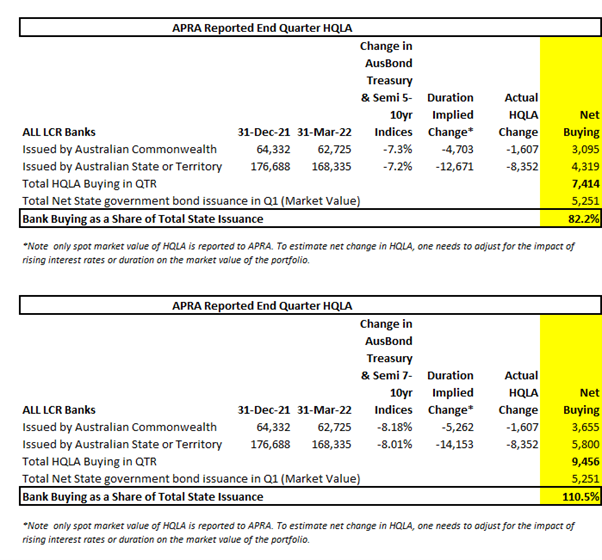Banks are net buying government bonds
The quarterly banking statistics from APRA make for interesting reading, and are very easy to misunderstand. Superficially, it appears as if the Aussie banking system net sold government bonds during the first quarter of 2022. However, deeper analysis shows banks were net buyers, and favoured State bonds over their Commonwealth equivalents.
The banks report their holdings of high-quality liquid assets (HQLA) on a spot, mark-to-market basis at the end of each quarter. These represent the valuations of the bonds they own, and do not include the independent valuations of the interest rate hedges they hold against them.
In the March quarter, the value of bank holdings of Commonwealth and State bonds fell by 2.5% and 4.7%, respectively, prompting some observers to suggest banks had reduced their holdings of HQLA. This is, however, incorrect.
Commonwealth and State bond valuations declined by between 7.2% and 8.2% over the March quarter as a result of a sharp increase in bond yields (assuming a 7.5-8.5 year maturity). To estimate how bank holdings of HQLA shifted over the quarter, one needs to adjust for the mark-to-market change in the bond valuations. We have done this in the two tables below, assuming average maturities of 7.5 and 8.5 years, which is broadly consistent with both the average maturity of outstanding debt securities and observed bank buying patterns.
Correcting for the impact of mark-to-market changes in valuations, Aussie banks net bought between $3.1bn and $3.7bn of Commonwealth bonds in the quarter and between $4.3bn and $5.8bn of State bonds. Bank buying therefore accounted for about 82% to 111% of the net new supply of State bonds in the quarter, which is in line with CCI's forecasts. (Gross buying would obviously have been larger than net buying.)
The March quarter was unusual because of the expected end of the RBA's QE program in February, which meant that bond issuance and activity was relatively light in the first month or so of the year.

1 topic